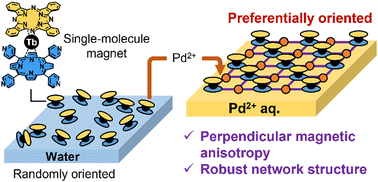Construction of a two-dimensional metal–organic framework with perpendicular magnetic anisotropy composed of single-molecule magnets†
Abstract
The use of single-molecule magnets (SMMs) as memory devices can dramatically increase information storage capacity. However, a regular array of SMMs needs to be constructed on a substrate to access individual SMMs. Various approaches for integrating SMMs two-dimensionally, such as self-assembled monolayers, Langmuir–Blodgett (LB) methods, vapor deposition, and encapsulation into metal–organic frameworks (MOFs), have been reported so far. Herein, we report a new method for constructing SMM nanosheets based on the formation of coordination bonds at the air–liquid interface. A phthalocyaninato-porphyrinato terbium(III) double-decker SMM substituted with four pyridyl units was synthesized and reacted with Pd2+ ions at the air–water interface. The formed MOF was mechanically robust and exhibited perpendicular magnetic anisotropy, which is promising for use in information storage. In contrast, the thin film formed without Pd2+ exhibited in-plane magnetic anisotropy owing to the disordered arrangement of SMMs. Furthermore, the reaction with Pd2+ ions increased the magnetic relaxation times in the high-temperature region. Our strategy for making the SMM nanosheet is promising compared with the previous method from the viewpoint of the high concentration of SMMs, structural regularity and designability, and versatility of substrate selection.

- This article is part of the themed collection: 2023 Journal of Materials Chemistry C HOT Papers


 Please wait while we load your content...
Please wait while we load your content...